Extraction of Lanthanum Oxide from Different Spent Fluid Catalytic Cracking Catalysts by Nitric Acid Leaching and Cyanex 923 Solvent Extraction Methods
Abstract
1. Introduction
2. Materials and Methods
2.1. Leaching Process of the Spent Fluid Catalytic Cracking Catalyst Powders
2.2. Liquid–Liquid Extraction Procedure
2.3. Stripping
2.4. Characterization
3. Results and Discussion
3.1. Leaching of the Spent FCCs
3.2. Extraction of the Lanthanum from the Spent FCC
3.2.1. Extraction of Lanthanum from Leaching Solutions
3.2.2. Stripping Process
3.3. Characterization of the Final Solid Products
3.3.1. X-ray Diffraction (XRD)
3.3.2. Thermogravimetric Analysis (TGA) and Differential Thermal Analysis (DTA)
3.3.3. Fourier Transform Infrared (FTIR)
3.3.4. Scanning Electron Microscopy (SEM)
3.3.5. Granulometric Analyses
4. Conclusions
Author Contributions
Funding
Data Availability Statement
Acknowledgments
Conflicts of Interest
References
- Le, T.; Wang, Q.; Ravindra, A.V.; Li, X.; Ju, S. Microwave intensified synthesis of Zeolite-Y from spent FCC catalyst after acid activation. J. Alloys Compd. 2019, 776, 437–446. [Google Scholar] [CrossRef]
- Wang, J.; Huang, X.; Cui, D.; Wang, L.; Feng, Z.; Hu, B.; Long, Z.; Zhao, N. Recovery of rare earths and aluminum from FCC waste slag by acid leaching and selective precipitation. J. Rare Earths 2017, 35, 1141–1148. [Google Scholar] [CrossRef]
- Sposato, C.; Catizzone, E.; Blasi, A.; Forte, M.; Romanelli, A.; Morgana, M.; Braccio, G.; Giordano, G.; Migliori, M. Towards the circular economy of rare earth elements: Lanthanum leaching from spent FCC catalyst by acids. Processes 2021, 9, 1369. [Google Scholar] [CrossRef]
- Zhou, Y.; Schulz, S.; Lindoy, L.F.; Du, H.; Zheng, S.; Wenzel, M.; Weigand, J.J. Separation and recovery of rare earths by in situ selective electrochemical oxidation and extraction from spent fluid catalytic cracking (FCC) catalysts. Hydrometallurgy 2020, 194, 105300. [Google Scholar] [CrossRef]
- Silva, J.S.; Medeiros de Jesus-Neto, R.; Fiuza, R.A.; Gonçalves, J.P.; Mascarenhas, A.J.S.; Andrade, H.M.C. Alkali-activation of spent fluid cracking catalysts for CO 2 capture. Microporous Mesoporous Mater. 2016, 232, 1–12. [Google Scholar] [CrossRef]
- Senter, C.; Mastry, M.C.; Zhang, C.C.; Maximuck, W.J.; Gladysz, J.A.; Yilmaz, B. Role of chlorides in reactivation of contaminant nickel on fluid catalytic cracking (FCC) catalysts. Appl. Catal. A Gen. 2021, 611, 117978. [Google Scholar] [CrossRef]
- Akah, A. Application of rare earths in fluid catalytic cracking: A review. J. Rare Earths 2017, 35, 941–956. [Google Scholar] [CrossRef]
- Ferella, F.; D’Adamo, I.; Leone, S.; Innocenzi, V.; De Michelis, I.; Vegliò, F. Spent FCC E-Cat: Towards a Circular Approach in the Oil Refining Industry. Sustainability 2018, 11, 113. [Google Scholar] [CrossRef]
- Maidel, M.; de Santana Ponte, M.J.J.; de Araújo Ponte, H.; Valt, R.B.G. Lanthanum recycling from spent FCC catalyst through leaching assisted by electrokinetic remediation: Influence of the process conditions on mass transfer. Sep. Purif. Technol. 2022, 281, 119905. [Google Scholar] [CrossRef]
- Wang, J.; Huang, X.; Wang, L.; Wang, Q.; Yan, Y.; Zhao, N.; Cui, D.; Feng, Z. Kinetics study on the leaching of rare earth and aluminum from FCC catalyst waste slag using hydrochloric acid. Hydrometallurgy 2017, 171, 312–319. [Google Scholar] [CrossRef]
- Akcil, A.; Vegliò, F.; Ferella, F.; Okudan, M.D.; Tuncuk, A. A review of metal recovery from spent petroleum catalysts and ash. Waste Manag. 2015, 45, 420–433. [Google Scholar] [CrossRef] [PubMed]
- Al-Jabri, K.; Baawain, M.; Taha, R.; Al-Kamyani, Z.S.; Al-Shamsi, K.; Ishtieh, A. Potential use of FCC spent catalyst as partial replacement of cement or sand in cement mortars. Constr. Build. Mater. 2013, 39, 77–81. [Google Scholar] [CrossRef]
- Vogt, E.T.C.; Weckhuysen, B.M. Fluid catalytic cracking: Recent developments on the grand old lady of zeolite catalysis. Chem. Soc. Rev. 2015, 44, 7342–7370. [Google Scholar] [CrossRef] [PubMed]
- Restrepo, E.; Vargas, F.; López, E.; Baudín, C. The potential of La-containing spent catalysts from fluid catalytic cracking as feedstock of mullite based refractories. J. Eur. Ceram. Soc. 2020, 40, 6162–6170. [Google Scholar] [CrossRef]
- Maheshwaran, G.; Selva Muneeswari, R.; Nivedhitha Bharathi, A.; Krishna Kumar, M.; Sudhahar, S. Eco-friendly synthesis of lanthanum oxide nanoparticles by Eucalyptus globulus leaf extracts for effective biomedical applications. Mater. Lett. 2021, 283, 128799. [Google Scholar] [CrossRef]
- Balaram, V. Rare earth elements: A review of applications, occurrence, exploration, analysis, recycling, and environmental impact. Geosci. Front. 2019, 10, 1285–1303. [Google Scholar] [CrossRef]
- Jyothi, R.K.; Thenepalli, T.; Ahn, J.W.; Parhi, P.K.; Chung, K.W.; Lee, J.-Y. Review of rare earth elements recovery from secondary resources for clean energy technologies: Grand opportunities to create wealth from waste. J. Clean. Prod. 2020, 267, 122048. [Google Scholar] [CrossRef]
- Chiranjeevi, T.; Pragya, R.; Gupta, S.; Gokak, D.T.; Bhargava, S. Minimization of Waste Spent Catalyst in Refineries. Procedia Environ. Sci. 2016, 35, 610–617. [Google Scholar] [CrossRef]
- Wenzel, M.; Schnaars, K.; Kelly, N.; Götzke, L.; Robles, S.M.; Kretschmer, K.; Le, P.N.; Tung, D.T.; Luong, N.H.; Duc, N.A.; et al. Hydrometallurgical Recovery of Rare Earth Metals from Spent FCC Catalysts; Springer: Cham, Switzerland, 2016; ISBN 9783319486161. [Google Scholar]
- Sadeghi, M.; Jesus, J.; Soares, H. Recycling spent fluid cracking catalysts for rare earth metal recovery: A review. Recycl. Sustain. Dev. 2018, 11, 43–52. [Google Scholar] [CrossRef]
- Zhao, Z.; Qiu, Z.; Yang, J.; Lu, S.; Cao, L.; Zhang, W.; Xu, Y. Recovery of rare earth elements from spent fluid catalytic cracking catalysts using leaching and solvent extraction techniques. Hydrometallurgy 2017, 167, 183–188. [Google Scholar] [CrossRef]
- Wang, J.; Xu, Y.; Wang, L.; Zhao, L.; Wang, Q.; Cui, D.; Long, Z.; Huang, X. Recovery of rare earths and aluminum from FCC catalysts manufacturing slag by stepwise leaching and selective precipitation. J. Environ. Chem. Eng. 2017, 5, 3711–3718. [Google Scholar] [CrossRef]
- Lin, X.; Fan, Y.; Liu, Z.; Shi, G.; Liu, H.; Bao, X. A novel method for enhancing on-stream stability of fluid catalytic cracking (FCC) gasoline hydro-upgrading catalyst: Post-treatment of HZSM-5 zeolite by combined steaming and citric acid leaching. Catal. Today 2007, 125, 185–191. [Google Scholar] [CrossRef]
- Madeti, M.; Lande, S.V.; Kalpana, G.; Mewada, R.K.; Jasra, R.V. A Green Approach. Int. J. Green Nanotechnol. 2013, 1, 194308921350702. [Google Scholar] [CrossRef]
- Gusev, A.A.; Psarras, A.C.; Triantafyllidis, K.S.; Lappas, A.A.; Diddams, P.A.; Vasalos, I.A. ZSM-5 Additive Deactivation with Nickel and Vanadium Metals in the Fluid Catalytic Cracking (FCC) Process. Ind. Eng. Chem. Res. 2020, 59, 2631–2641. [Google Scholar] [CrossRef]
- Ferella, F.; Leone, S.; Innocenzi, V.; De Michelis, I.; Taglieri, G.; Gallucci, K. Synthesis of zeolites from spent fluid catalytic cracking catalyst. J. Clean. Prod. 2019, 230, 910–926. [Google Scholar] [CrossRef]
- Alguacil, F.J.; López, F.A. The extraction of mineral acids by the phosphine oxide Cyanex 923. Hydrometallurgy 1996, 42, 245–255. [Google Scholar] [CrossRef]
- Grivel, J.-C.; Zhao, Y.; Suarez Guevara, M.J.; Watenphul, A. Studies on the thermal decomposition of lanthanum(III) valerate and lanthanum(III) caproate in argon. Thermochim. Acta 2015, 612, 1–9. [Google Scholar] [CrossRef]
- Purwani, M.V.; Suyanti, S.; Adi, W.A. THERMAL DECOMPOSITION KINETICS OF LANTHANUM OXALATE HYDRATE PRODUCT TREATMENT FROM MONAZITE. J. Sains Mater. Indones. 2019, 20, 50. [Google Scholar] [CrossRef][Green Version]
- Balboul, B.A.; El-Roudi, A.M.; Samir, E.; Othman, A.G. Non-isothermal studies of the decomposition course of lanthanum oxalate decahydrate. Thermochim. Acta 2002, 387, 109–114. [Google Scholar] [CrossRef]
- ZHAN, G.; YU, J.; XU, Z.; ZHOU, F.; CHI, R. Kinetics of thermal decomposition of lanthanum oxalate hydrate. Trans. Nonferrous Met. Soc. China 2012, 22, 925–934. [Google Scholar] [CrossRef]
- Dumitru, R.; Negrea, S.; Ianculescu, A.; Păcurariu, C.; Vasile, B.; Surdu, A.; Manea, F. Lanthanum Ferrite Ceramic Powders: Synthesis, Characterization and Electrochemical Detection Application. Materials 2020, 13, 2061. [Google Scholar] [CrossRef] [PubMed]
- Bîrzescu, M.; Niculescu, M.; Dumitru, R.; Carp, O.; Segal, E. Synthesis, structural characterization and thermal analysis of the cobalt(II) oxalate obtained through the reaction of 1,2-ethanediol with Co(NO3)2 · 6H2O. J. Therm. Anal. Calorim. 2009, 96, 979–986. [Google Scholar] [CrossRef]
- Nakamoto, K. Infrared and Raman Spectra of Inorganic and Coordination Compounds; John Wiley & Sons, Inc.: Hoboken, NJ, USA, 2008; ISBN 9780470405840. [Google Scholar]
- Karthikeyan, S.; Selvapandiyan, M. Effect of Annealing Temperature on the Properties of Lanthanum Oxide (La2O3) Nanoplates by Reflux Routes. Int. J. Eng. Sci. Res. Technol. 2018, 7, 559–562. [Google Scholar] [CrossRef]
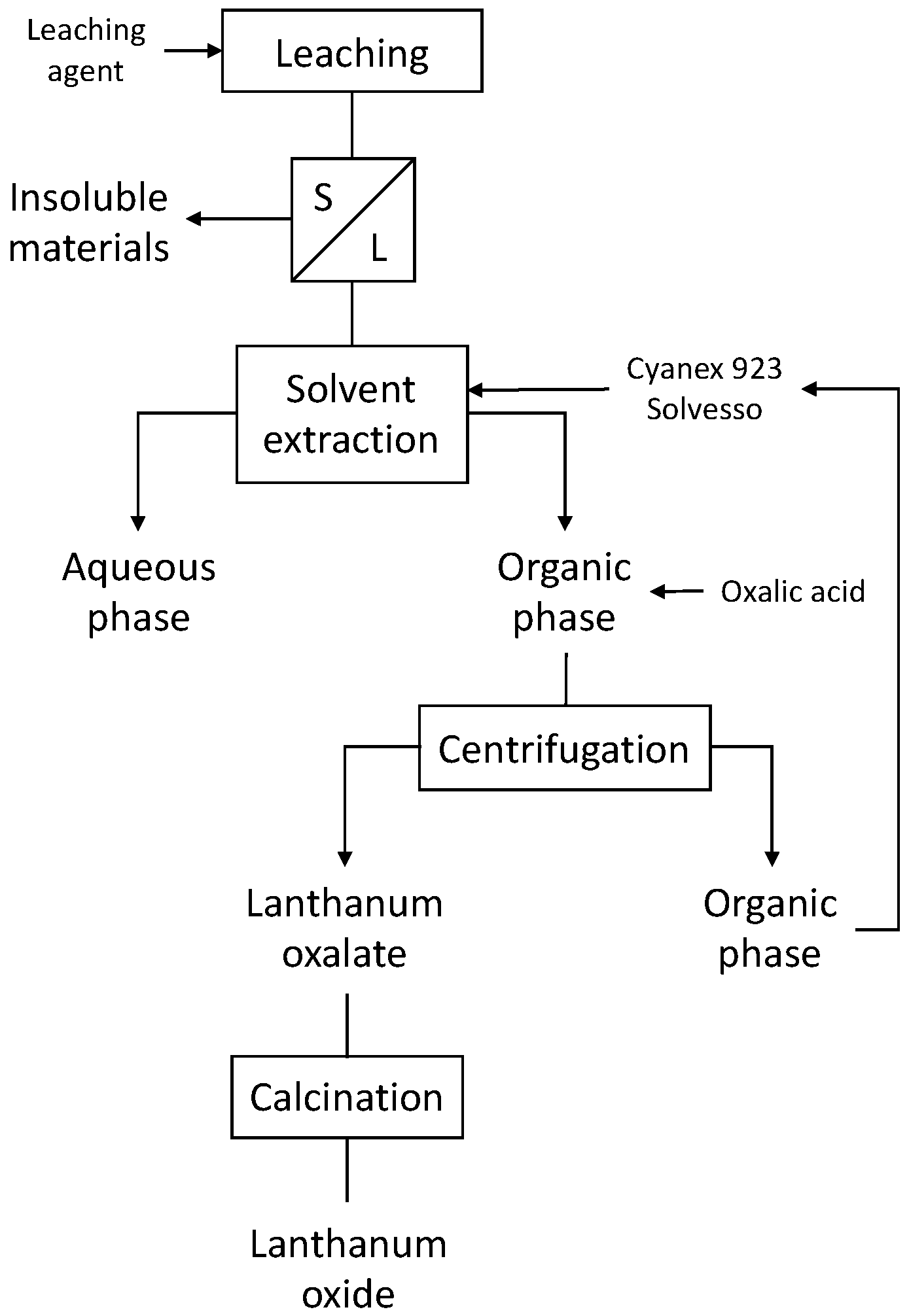
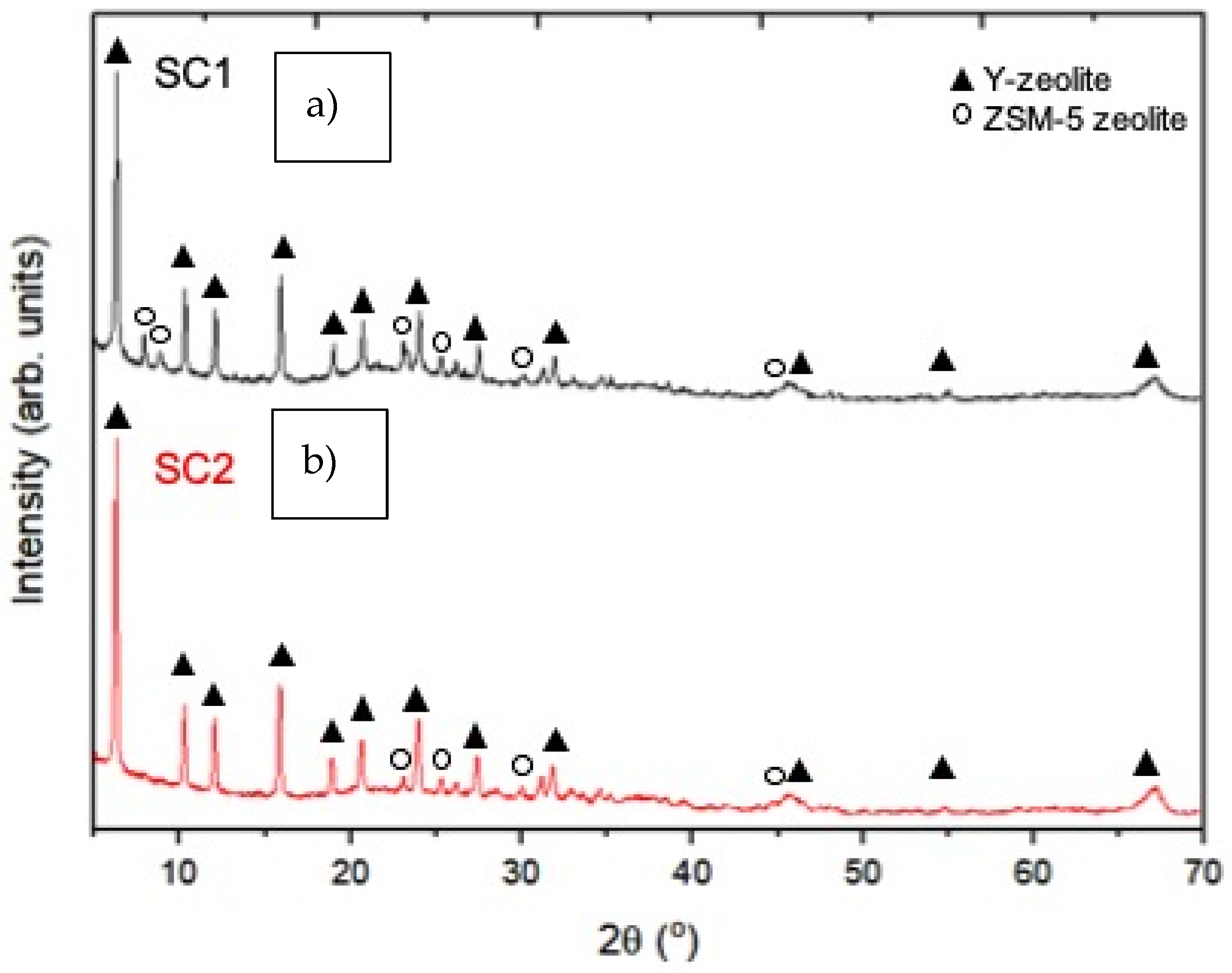

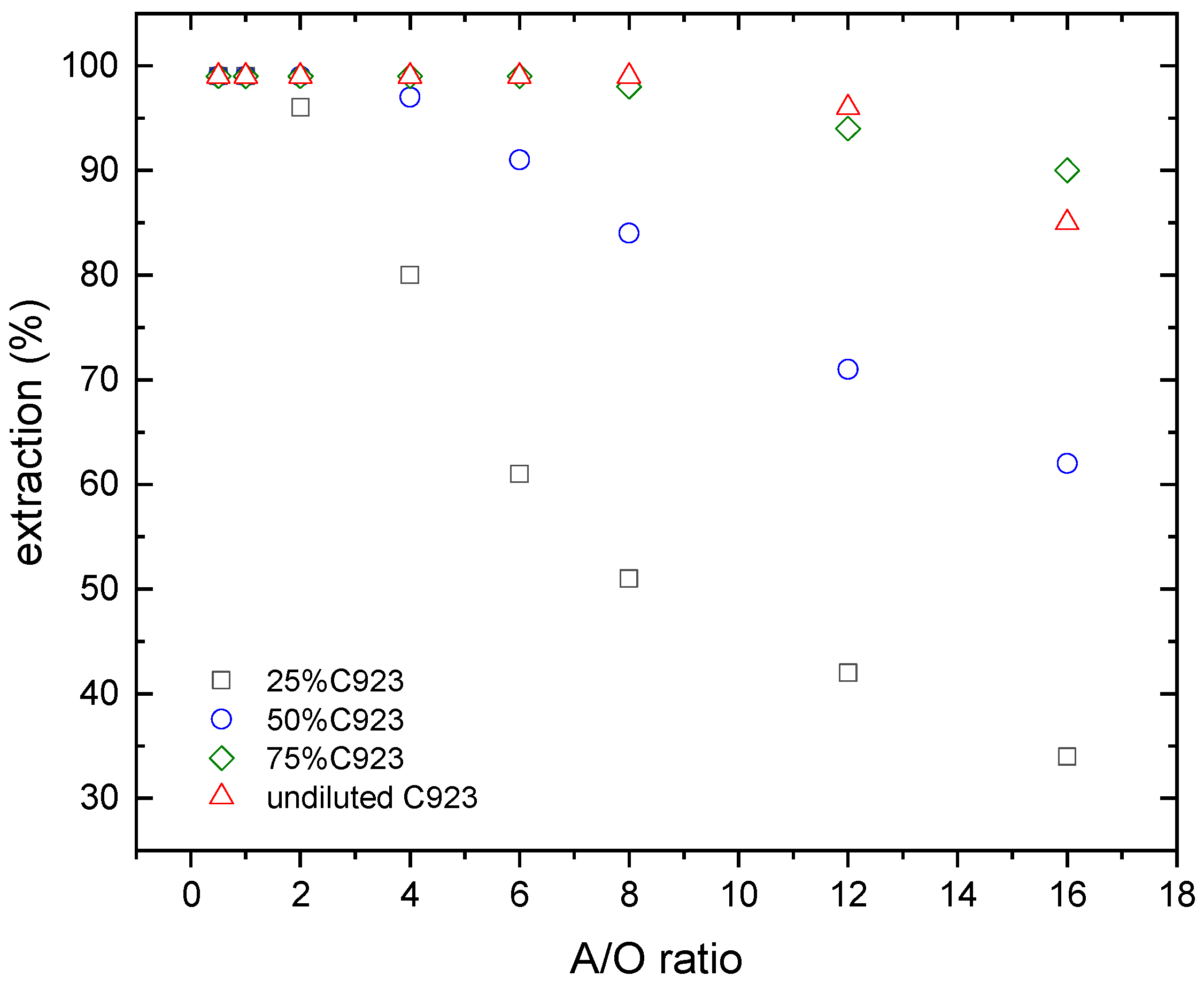

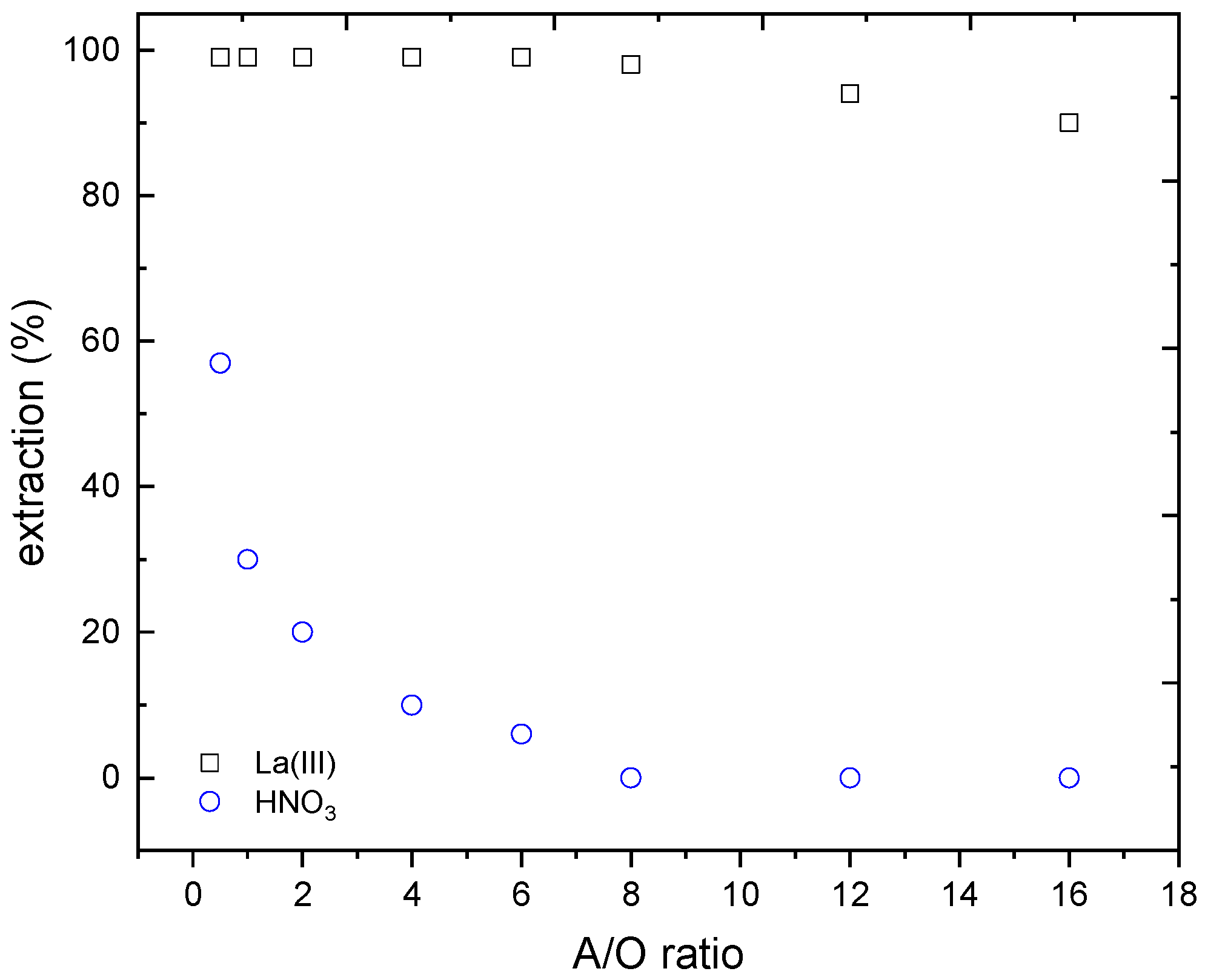
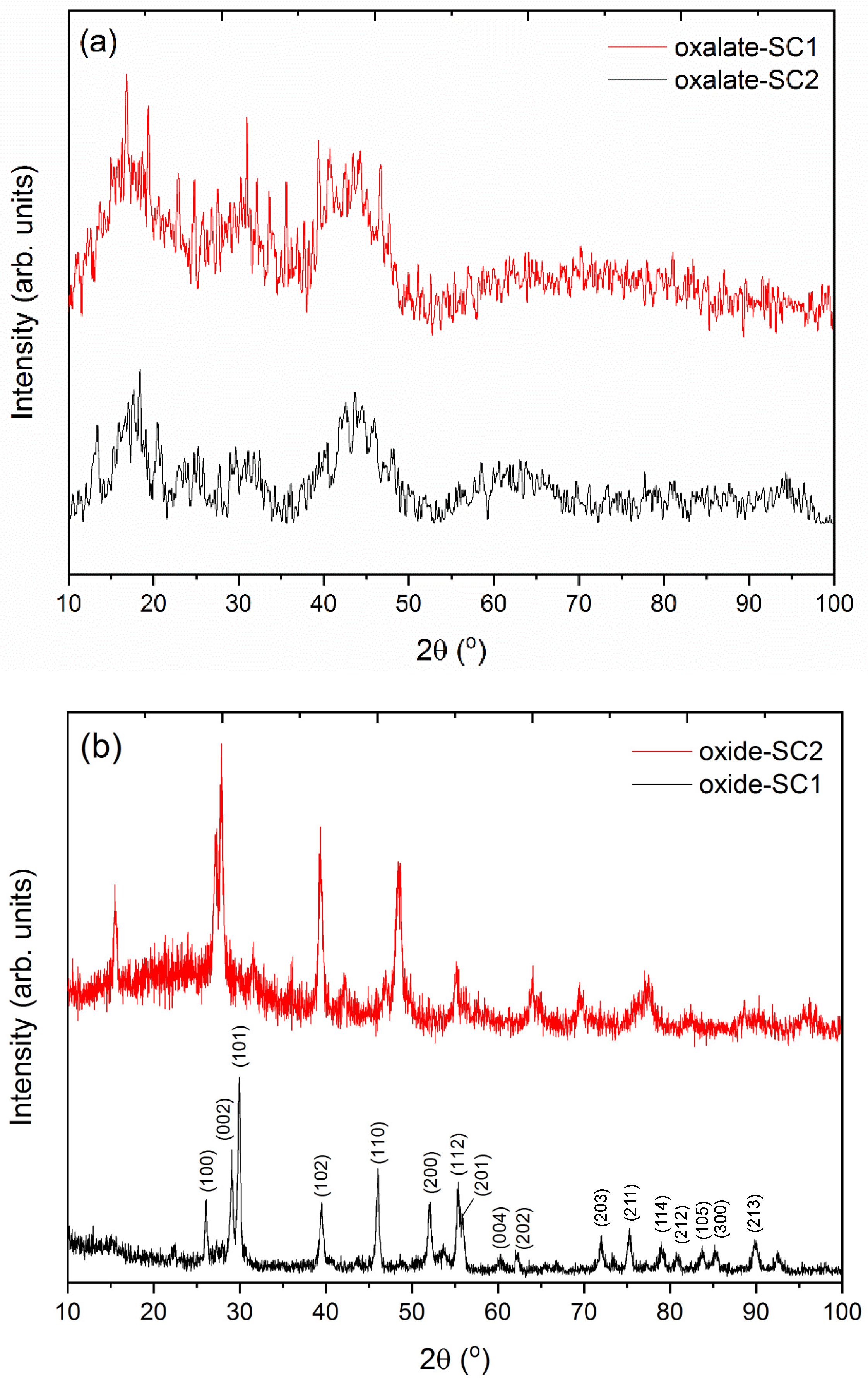

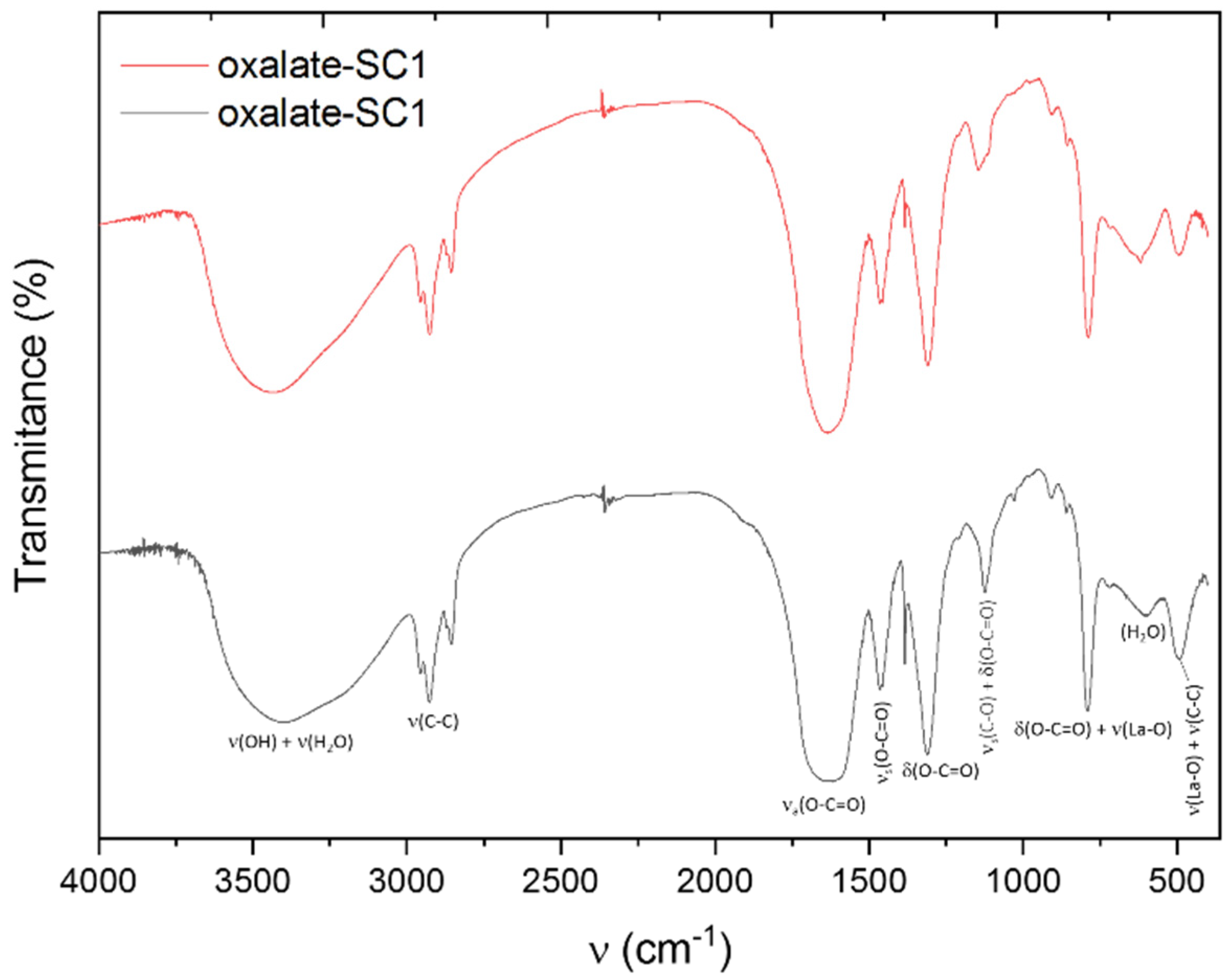


| Oxide (wt%) | SC1 | SC2 |
|---|---|---|
| Al2O3 | 50.00 | 52.20 |
| SiO2 | 45.60 | 39.10 |
| La2O3 | 1.82 | 4.32 |
| V2O5 | nd | 0.24 |
| Na2O | 0.19 | 0.30 |
| P2O5 | 0.94 | 0.27 |
| TiO2 | 0.89 | 0.64 |
| Fe2O3 | 0.43 | 0.36 |
| CeO2 | nd | 0.26 |
| NiO | 0.12 | nd |
| MgO | nd | 0.88 |
| SO3 | nd | 1.25 |
| La (mg/L) | SC1 | SC2 |
|---|---|---|
| HCl | 1.55 | 3.60 |
| HNO3 | 1403 | 3275 |
| OA | 0.2 | 0.4 |
| NaOH | <0.05 | <0.05 |
| HNO3 (M) | SC1 | SC2 | ||
|---|---|---|---|---|
| Nº | La Recovery (%) | Nº | La Recovery (%) | |
| 2 | 2 | 82 | 6 | 85 |
| 1.5 | 9 | 97 | 12 | 95 |
| 1 | 10 | 47 | 13 | 74 |
| 0.5 | 11 | 66 | 14 | 83 |
| Oxide (wt%) | SC1-B | SC2-B |
|---|---|---|
| Al2O3 | 38.6 | 44.5 |
| SiO2 | 59.2 | 52.7 |
| La2O3 | 0.33 | 0.52 |
| V2O5 | nd | 0.15 |
| Na2O | nd | nd |
| P2O5 | 0.25 | 0.096 |
| TiO2 | 1.12 | 0.87 |
| Fe2O3 | 0.26 | 0.23 |
| CeO2 | nd | 0.28 |
| NiO | 0.15 | <0.05 |
| MgO | nd | 0.47 |
| SO3 | nd | 0.18 |
| Al2O3/SiO2 | 0.65 | 0.84 |
| Oxide (wt%) | |
|---|---|
| La2O3 | 98.06 |
| CeO2 | 1.38 |
| Al2O3 | 0.22 |
Publisher’s Note: MDPI stays neutral with regard to jurisdictional claims in published maps and institutional affiliations. |
© 2022 by the authors. Licensee MDPI, Basel, Switzerland. This article is an open access article distributed under the terms and conditions of the Creative Commons Attribution (CC BY) license (https://creativecommons.org/licenses/by/4.0/).
Share and Cite
Alcaraz, L.; Largo, O.R.; Alguacil, F.J.; Montes, M.Á.; Baudín, C.; López, F.A. Extraction of Lanthanum Oxide from Different Spent Fluid Catalytic Cracking Catalysts by Nitric Acid Leaching and Cyanex 923 Solvent Extraction Methods. Metals 2022, 12, 378. https://doi.org/10.3390/met12030378
Alcaraz L, Largo OR, Alguacil FJ, Montes MÁ, Baudín C, López FA. Extraction of Lanthanum Oxide from Different Spent Fluid Catalytic Cracking Catalysts by Nitric Acid Leaching and Cyanex 923 Solvent Extraction Methods. Metals. 2022; 12(3):378. https://doi.org/10.3390/met12030378
Chicago/Turabian StyleAlcaraz, Lorena, Olga Rodríguez Largo, Francisco J. Alguacil, Margarita Álvarez Montes, Carmen Baudín, and Félix A. López. 2022. "Extraction of Lanthanum Oxide from Different Spent Fluid Catalytic Cracking Catalysts by Nitric Acid Leaching and Cyanex 923 Solvent Extraction Methods" Metals 12, no. 3: 378. https://doi.org/10.3390/met12030378
APA StyleAlcaraz, L., Largo, O. R., Alguacil, F. J., Montes, M. Á., Baudín, C., & López, F. A. (2022). Extraction of Lanthanum Oxide from Different Spent Fluid Catalytic Cracking Catalysts by Nitric Acid Leaching and Cyanex 923 Solvent Extraction Methods. Metals, 12(3), 378. https://doi.org/10.3390/met12030378









